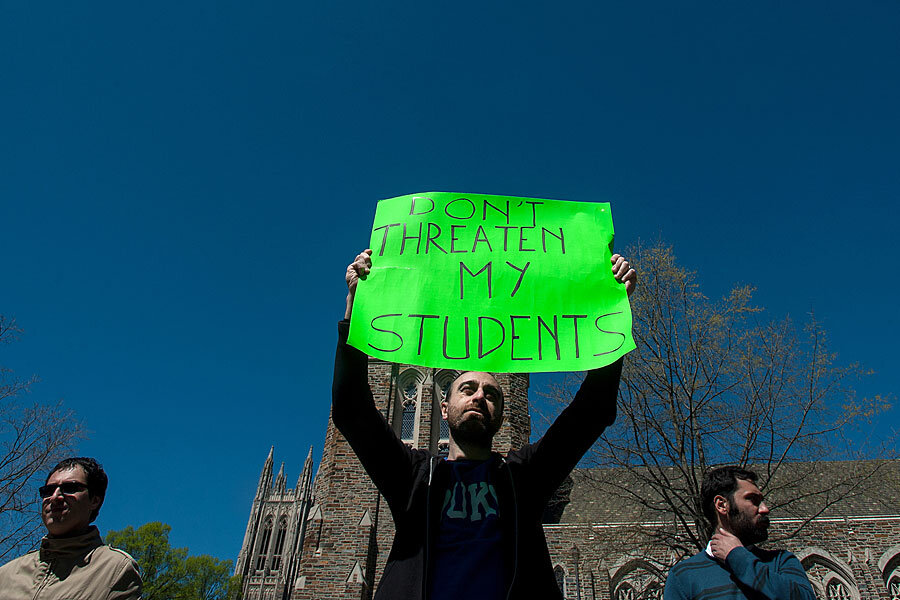Why Duke protesters are refusing to leave that administration building
In the latest wave of campus activism, Duke University students are continuing to protest what they call patterns of racism on campus, despite an order yesterday to vacate the administration building.
Demonstrators affiliated with the group "Duke Students and Workers in Solidarity" started protesting last Friday, adding their voice to what some say is burgeoning political activism across university campuses, spurred by an election year and the Black Lives Matter movement.
On Tuesday, say protesters, they "made another attempt in good faith to re-enter negotiation with administration," outlining that they wanted to meet first with a group of workers, faculty, and community members, and only then meet with the administration.
Eight students have been told to leave the Allen building, a Duke University administration building. Students say they will not leave until the University agrees to meet a list of demands, which it recently shortened in what protesters call a "gesture of goodwill." Administrators have said that they will not negotiate directly until the occupation ends, although they have agreed to set up a task force to look into several issues raised by the student protesters.
The protest is a response what members call a pattern of behavior over the past several years, including a 2014 incident where they say Duke vice president Tallman Trask III hit an African-American contract worker with his car, called her stupid, and used a racial slur against her.
Former Duke parking and transportation employee Renee Adkins told The Christian Science Monitor by phone that she attempted for years to communicate with university officials, including the university president, in order to establish a dialogue on race and other issues, but that she was rebuffed every time.
"No one wanted to talk to us about our treatment," Ms. Adkins says. "It is a part of the institutional racism at Duke University."
Eventually, students who heard about the situation with university workers decided to get involved.
"The students decided that since they [administrators] didn't want to listen to us [employees]," Adkins says, "that they would maybe want to listen to the students who were backing us."
Students have tried to force the university to listen, ignoring institutional demands to end their now weeklong sit-in.
While protesters say that administrators are reluctant to sit down and negotiate, the university says it has taken steps to meet students in the middle.
On Wednesday, Duke president Richard Brodhead issued a written statement expressing willingness to accede to several protester demands. In addition to pledging to have an expert review the staff complaint process, he also agreed to look into raising the university’s minimum wage from $12 per hour to $15.
"While Duke has been frequently recognized as a leader in employee benefits and satisfaction," wrote Dr. Brodhead, "the recent student protest is consistent with our own commitment to continually review and improve our workplace culture."
Students and workers both denounce Brodhead's pledge as insincere.
"In the past, the university has created task forces and committees as a way to quell student activism and to divert attention away from important news stories," wrote protesters in a statement. "These task forces and committees often lack clear timelines, material goals, and procedures of accountability. The student occupiers want their demands to be met with a tangible and public commitment by the university."
Adkins agrees with the protesters' statement, saying, "It is absolutely insincere. These are things that have been complained about for years. They don't want to dialogue about this, and we know it, because we have dealt with his insincerity for so long."
Many see the growing trend of campus protests as reminiscent of those in the 1960s.
College protests have gone on for centuries, but they reached their greatest heights during the civil rights era, says Harvard education professor Dr. Natasha Warikoo.
Others say that students are turning to protest in response to increasing disillusionment regarding their own political agency.
"Young people have started to say they can't trust the vote, that they can't trust elected officials," civic engagement expert and Tufts University professor Kei Kawashima-Ginsberg told the Monitor by phone, "so they have turned to other ways to make an impact, like protest."
The roots of many of the recent campus protests, including those at the University of Missouri last fall, stem from racial concerns. Although #BlackLivesMatter is not the only face of the racial justice movement, says Dr. Warikoo, "The Black Lives Matter movement is a national movement that goes well beyond universities, but students at universities are uniquely poised to take part."
What can administrators learn from these latest protests?
Dr. Kawashima-Ginsberg says campuses are often most politically charged in election years, and adds that administrators need to remember that student life and administrative schedules move at different speeds. Students may expect results faster than what administrators can really promise.
Warikoo adds that administrators need to be genuine when dealing with protesters and their concerns. "The most important thing is to really listen to students," she says, "and really take their concerns seriously. I’m a firm believer in dialogue."







